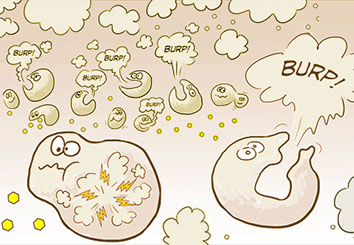SciGen Teacher Dashboard
Unit L5
The Sensational Single Cell
 Reading: Rise of the Yeast Cells
Reading: Rise of the Yeast Cells
Duration: Approximately 50 minutes
Learn more about the cell biology of single-celled organisms—and of bread baking!—in this whimsical comic. The four-page explainer shows yeast cells getting energy, obtaining building materials, disposing of waste, and storing and following inheritable instructions. And they also crack jokes.
LEARNING OBJECTIVES
Learn any cell's four essential functions: storing and passing on operating instructions; getting energy; obtaining building materials; disposing of waste.
NGSS Disciplinary Core Ideas: All living things are made up of cells, which is the smallest unit that can be said to be alive. An organism may consist of one single cell (unicellular) or many different numbers and types of cells (multicellular). (MS-LS1-1) Within cells, special structures are responsible for particular functions, and the cell membrane forms the boundary that controls what enters and leaves the cell. (MS-LS1-2) Within individual organisms, food moves through a series of chemical reactions in which it is broken down and rearranged to form new molecules, to support growth, or to release energy. (MS-LS1-7) Cellular respiration in plants and animals involve chemical reactions with oxygen that release stored energy. In these processes, complex molecules containing carbon react with oxygen to produce carbon dioxide and other materials. (secondary to MS-LS1-7)
Teacher Tips
- This is a four-page comic. It can be read on-screen or printed as two double-sided, stapled sheets or on folded legal-sized sheets of paper that get folded after printing double-sided.
- This lesson plan assumes students have been introduced to cells and the idea that they have various components that play special roles within them.
Teacher Tune-ups
Teaching Notes
ACTIVITY OVERVIEW
- Set the context for the comic (10 minutes)
- Read the comic (30 minutes)
- Review the activity (10 minutes)
Set the context for the comic (10 minutes)
Optional demo extension
Sample Prompt:
Read the comic (30 minutes)
This is a four-page comic explainer that deepens student's understanding of the four basic functions of cells: getting energy, obtaining building materials, disposing of waste, and storing and following inheritable instructions.
Students stay on task best when reading this out loud with at least one other student.
Paraphrase:
I'll give you a half hour to read this comic with a partner. Take turns reading panels. Stop after each panel and write down one or two things that stand out about what is happening in the comic.
Review the activity (10 minutes)
When finished with the activity, ask students to answer these questions.
For the final question, judge whether you feel your students can respond in an appropriate manner.
Respond in writing to the questions, then compare and discuss your answers with someone else.
![]() What does yeast use sugar for?
What does yeast use sugar for? ![]() What are two waste products that yeast produces?
What are two waste products that yeast produces?
![]() What are three things the cell membrane does?
What are three things the cell membrane does?
Baker’s yeast is used for making bread; brewer’s yeast (a closely related kind of yeast) is used for brewing beer. Both kinds of yeast produce carbon dioxide waste. When there is no oxygen present, both kinds of yeast also produce alcohol (though the alcohol evaporates out of bread when it gets baked).
Explain how the waste products of yeast are useful to beer makers. Where do you think the bubbles in beer come from?
BETA Version - Please send comments and corrections to info@serpinstitute.org
